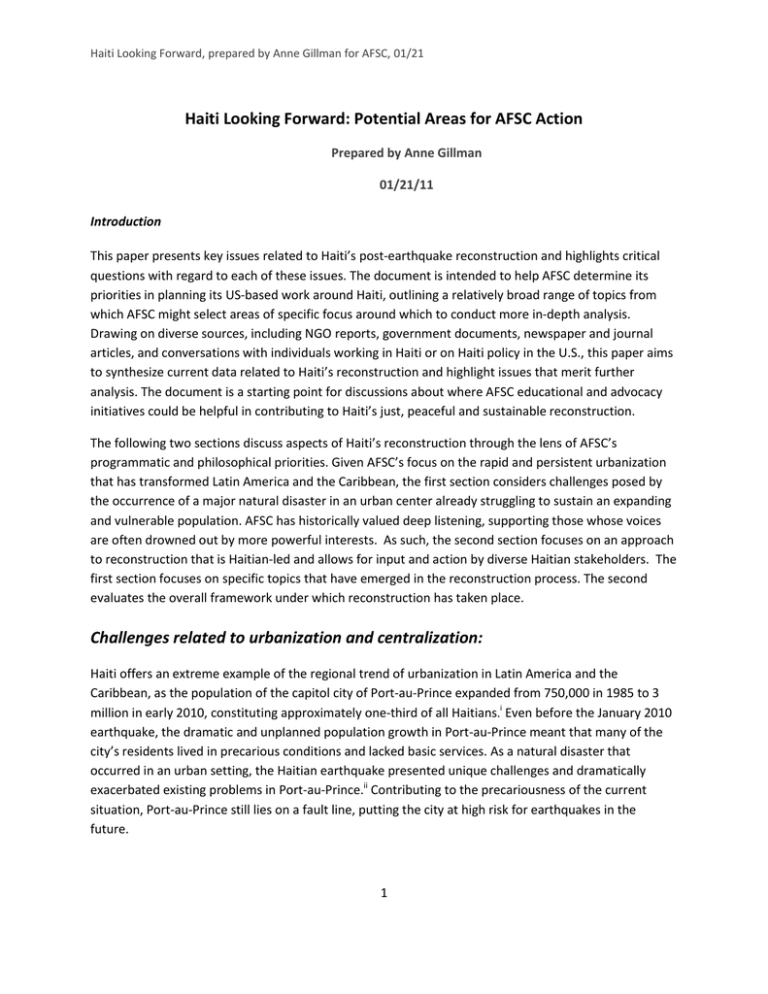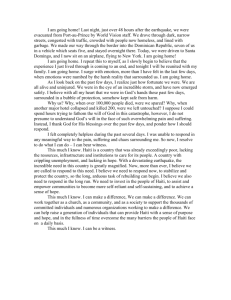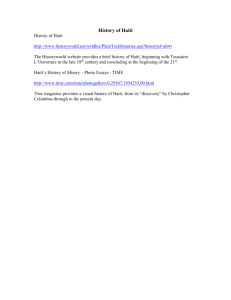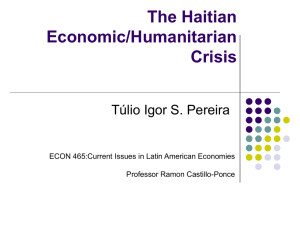Haiti Looking Forward: Potential Areas for AFSC Action
advertisement

Haiti Looking Forward, prepared by Anne Gillman for AFSC, 01/21 Haiti Looking Forward: Potential Areas for AFSC Action Prepared by Anne Gillman 01/21/11 Introduction This paper presents key issues related to Haiti’s post-earthquake reconstruction and highlights critical questions with regard to each of these issues. The document is intended to help AFSC determine its priorities in planning its US-based work around Haiti, outlining a relatively broad range of topics from which AFSC might select areas of specific focus around which to conduct more in-depth analysis. Drawing on diverse sources, including NGO reports, government documents, newspaper and journal articles, and conversations with individuals working in Haiti or on Haiti policy in the U.S., this paper aims to synthesize current data related to Haiti’s reconstruction and highlight issues that merit further analysis. The document is a starting point for discussions about where AFSC educational and advocacy initiatives could be helpful in contributing to Haiti’s just, peaceful and sustainable reconstruction. The following two sections discuss aspects of Haiti’s reconstruction through the lens of AFSC’s programmatic and philosophical priorities. Given AFSC’s focus on the rapid and persistent urbanization that has transformed Latin America and the Caribbean, the first section considers challenges posed by the occurrence of a major natural disaster in an urban center already struggling to sustain an expanding and vulnerable population. AFSC has historically valued deep listening, supporting those whose voices are often drowned out by more powerful interests. As such, the second section focuses on an approach to reconstruction that is Haitian-led and allows for input and action by diverse Haitian stakeholders. The first section focuses on specific topics that have emerged in the reconstruction process. The second evaluates the overall framework under which reconstruction has taken place. Challenges related to urbanization and centralization: Haiti offers an extreme example of the regional trend of urbanization in Latin America and the Caribbean, as the population of the capitol city of Port-au-Prince expanded from 750,000 in 1985 to 3 million in early 2010, constituting approximately one-third of all Haitians.i Even before the January 2010 earthquake, the dramatic and unplanned population growth in Port-au-Prince meant that many of the city’s residents lived in precarious conditions and lacked basic services. As a natural disaster that occurred in an urban setting, the Haitian earthquake presented unique challenges and dramatically exacerbated existing problems in Port-au-Prince.ii Contributing to the precariousness of the current situation, Port-au-Prince still lies on a fault line, putting the city at high risk for earthquakes in the future. 1 Haiti Looking Forward, prepared by Anne Gillman for AFSC, 01/21 Meeting survival needs: Water, sanitation and health Even prior to the earthquake, Haiti had among the worst sanitation systems in the world. Adequate sanitation and the supply of drinkable water are currently among the most critical needs in Port-auPrince. Six months after the earthquake, in Congressional hearings and written reports, experts urged the US government to do more to ensure access to clean water and proper sanitation, predicting that failure to meet these needs could lead to a major health epidemic.iii Tragically, these predictions have come true. To date, cholera, has claimed more than 3,500 lives in Haiti, and is contributing to a climate of desperation as it spreads throughout the country and now into the Dominican Republic.iv Critical questions: The cholera epidemic has been portrayed by some as epitomizing the failures of the international community. Why was this predictable disaster not avoided? What went wrong? Some have pointed to delays in the release of relief funds by the US. Others have noted lack of coordination among donors and NGOs. Assessing why the current health crisis was not prevented can reveal crucial lessons for the US and donor community in the future. Coordination remains a problem, as many NGOs that were funded for what was expected to be temporary provision of relief services have pulled out, even as immediate survival needs remain unmet for many.v Many committed funds by donors have still not been delivered.vi Perhaps more importantly, however, given evidence that cholera was likely introduced to the island by UN peacekeepers,vii the current crisis should raise awareness that well-intentioned interventions by the international community can have unintended disastrous effects. How can the “first do no harm” principle be applied in relief efforts? The epidemic also highlights the major long-term challenge of establishing the infrastructure and achieving the logistical coordination to sustain the population in Port-au-Prince. Decentralization Intending to “build back better,” the Haitian government has emphasized decentralization as a major objective. The administration of President Rene Préval stated early on the goal of developing secondary cities, noting that the current population concentration in the capital is unsustainable. Decentralization has also been touted as a key priority by the U.S. USAID has undertaken efforts to deliver food, shelter, job programs and other services to communities around the country in anticipation of an influx of people from the capital.viii As of July, however, of the 600,000 survivors who left the capital after the earthquake, many had returned because the scarce resources that are needed to survive are distributed mostly in the capital.ix Critical questions: The objective of “decentralization” has multiple components—economic, political, and demographic—and the viability and potential impact of each should be assessed. For example, advocates of political decentralization often argue that wider distribution of power to local poles will improve government accountability and reduce corruption. Yet others have suggested that political decentralization contributes to corruption, weakening capacity for oversight and expanding opportunities for the development of clientelist relationships.x While the challenges and dangers of the current concentration of Haiti’s population in Port-au-Prince are easily recognized, decentralization is 2 Haiti Looking Forward, prepared by Anne Gillman for AFSC, 01/21 not a simple or uncontroversial solution. What specifically do the US and donors refer to when they use this term in defining strategic objectives? What models of political and economic decentralization are being promoted? What are the potential risks or draw backs? Housing and land tenure While an estimated 1.35 million people were still displaced in Haiti as of September 2010, most living in tent cities built as temporary shelters after the earthquake, the number of internally displaced persons (IDPs) had diminished to approximately 810,000 as of January 2011.xi While available data suggests that some 200,000 IDPs have been helped to relocate by international aid efforts, the majority seem to have left of their own initiative.xii Rubble removal still remains a major impediment to resettling people to permanent shelters, as most debris from the earthquake has not been removed.xiii The issue of land tenure also presents a challenge for the long-term resettlement of displaced Haitians, as well as those who lived in precarious conditions before the earthquake. Camp residents have suffered evictions, and in some cases landowners have prohibited that improvements be made on camps on their land.xiv Notably, in some cases, camp residents have better access to services and experience greater security than when they lived in squatter communities before the earthquake. Critical questions: U.S. policy regarding resettlement of camp residents has outlined five solutions, including: returning to original safe houses, returning to plots near former houses, residing with host families, remaining in spontaneous settlements made safer through engineering improvements, or moving to planned resettlement sites identified by the Haitian government.xv These solutions do not, however, address the contentious and politically-charged issue of land tenure. In the midst of Haiti’s political crisis, how can the state exercise authority to establish sites for resettlement? And absent this state role, how are sites for reconstruction and resettlement being determined? Even before the earthquake, large populations of Port-au-Prince residents lacked legal rights to the land they inhabited, paying usurious rents or living in squatter communities. The question of who owns land, and who has a right to live on that land, is related to historic inequalities in Haiti that have persisted into the present. Livelihoods At least half of Haiti’s population was unemployed even before the earthquake,xvi and ensuring sustainable livelihoods for current inhabitants of Port-au-Prince is a major challenge. Devastating ecological degradation has contributed to rural unemployment and consequently mass urban migration; ninety eight percent of forest cover has been destroyed, largely related to reliance on charcoal fuel for energy.xvii Lack of educational opportunities also presents an ongoing challenge for generating sustainable employment, and 65% of schools and 95% of the universities in Haiti collapsed in the earthquake.xviiiIn the short run, some analysts have suggested that the major influx of international aid should lead to job creation, though to date only slightly over 100,000 Haitians have been employed through relief efforts.xix Redistribution of income and wealth will also be necessary if economic growth is to lead to poverty reduction and improved livelihoods; when the level of inequality is as high as Haiti’s, the capacity of economic growth to reduce poverty approaches zero.xx 3 Haiti Looking Forward, prepared by Anne Gillman for AFSC, 01/21 Critical questions: Prior to the earthquake, the majority of Haiti’s employed population worked in agriculture,xxi and in promoting livelihood development the US has emphasized strengthening this sector, providing assistance to improve Haiti’s ability to export cash crops such as coffee and mangoes. Yet, trade liberalization policies promoted by the US and driven by US commercial interests have also undermined the viability of Haiti’s agricultural sector. For example, the Haitian market is now flooded with US rice imports, contributing to the significant decline in Haitian rice production and decreased capacity to provide for its own food security. How do aid and development projects intersect with trade policies promoted by other sectors of the US government? What US interests are implicated in the agricultural policies currently being promoted by the US in Haiti? The US model for employment generation has focused almost primarily on stimulating economic growth rather than encouraging the kinds of fiscal and social welfare policies that would redistribute wealth within the country. To what extent are redistributive policies being advanced to ensure that expanded economic production actually leads to sustainable livelihoods for the working and low-income classes of Haiti? Finally, it is important to acknowledge that despite efforts of the development industry to expand employment opportunities in rural areas over recent decades, urbanization has persisted at rapid rates. To what extent are international donors promoting pro-urban policies for generating sustainable livelihoods? Conflict resolution and security: Since immediately after the earthquake the security situation in Port-au-Prince has deteriorated, as incidences of armed violence in camps have risen significantly.xxii In the aftermath of the earthquake, violence in Haiti has stemmed from historic sources of conflict, such as elections and land rights, as well as from new sources, such as the cholera epidemic.xxiii Gender-based violence in particular is a grave and increasing concern.xxiv Many have called for improvements in basic security measures within camps, such as better lighting and more effective policing, as well as for broader scale reforms to strengthen the justice system within Haiti. The perceived ineffectiveness of relief and reconstruction efforts, as well as inequalities in resource distribution across camps managed by NGOs with different capacities, has contributed to widespread feelings of frustration and resentment among camp residents. Many of the issues that must be negotiated in the path to reconstruction will inevitably generate intense conflict that may lead to violence if not addressed. Critical questions: The US has primarily responded to rising concerns about violent conflict in Haiti by providing support for the security sector, including policing, corrections, and counter-narcotics. Such initiatives are focused on controlling or mitigating violence and often do not address root causes. What are the underlying sources of conflict in Haiti? Addressing this question requires a deepened understanding of systems of structural violence within the country, examining historical patterns of inequality and exclusion. Such an approach implies working at different levels with diverse actors within the international community, government, academia and the business sector. Improving security in Haiti over the long term also entails institution building, as the country struggles to rebuild its justice system. Given the weakness of the formal Haitian judicial system, the foundations of which were 4 Haiti Looking Forward, prepared by Anne Gillman for AFSC, 01/21 imported from France, justice tends to be administered through informal channels by traditional social and religious figures. The US has provided technical support for government capacity building in the rebuilding of the justice and security sectors. What institutional models are being promoted through this exchange, and how do they correspond with Haitian ideals and systems of justice? Haitian-led reconstruction: An often repeated criticism of reconstruction efforts thus far is that Haitians, and primarily those most directly impacted by reconstruction projects, have not been sufficiently involved in the conception, implementation, and evaluation of such initiatives. Lack of communication between impacted Haitians and agents of the “international community” determining and managing reconstruction is an ongoing problem, as information is neither adequately shared with, nor solicited from, Haitian stakeholders. In considering means of expanding Haitian participation and decision-making power, it is important to note that Haitians do not speak in a unitary voice. Referring to “Haitian-led” reconstruction,” “Haitian voices”, or the “Haitian community,” it is critical to resist oversimplifying what is actually a complex array of opinions, positions and interests. Listening, communicating and respecting Haitian local capacity Haitian civil society leaders and camp residents are often not included in conversations about planning and implementation of projects. In many cases, information about projects is communicated only in English and at meetings where Haitians are generally not present.xxv The current “communication gap” makes Haitians in camps feel that nothing is being done, and their concerns are not being heard.xxvi Leaders have emerged in many camps, and Haiti has a diversity of domestic civil society organizations with significant experience carrying out development projects. Harnessing and building the capacity of Haitian civil society leaders and camp leaders will be critical to sustainable and just reconstruction. Critical questions: Officially, the U.S. and other donors have promoted a strategy that is “Haitian-led,” and participatory processes are often written into projects. Which individuals or organizations are selected to serve as the interlocutors of “Haitian needs” in the establishment, management and evaluation of projects? Which voices are heard, and which interests are represented? Of the 1,583 U.S. contracts given so far for reconstruction in Haiti, totaling $267 million, only 20 have been awarded to Haitian-owned companies. xxvii To what extent is international assistance capitalizing on and building Haitian capacity as opposed to fostering dependencies? Government legitimacy and supporting state capacity Haiti’s long-term sustainable development depends on a national government that has public support and is capable of fulfilling critical functions: channeling and representing diverse citizen interests, ensuring security, and coordinating and implementing service delivery. Already unable to perform these functions, the Haitian state was severely weakened by the earthquakexxviii and efforts to stabilize the government and carry out new elections since the disaster have been characterized by confusion, 5 Haiti Looking Forward, prepared by Anne Gillman for AFSC, 01/21 corruption and scandal.xxix In the face of significant irregularities in the recent national elections,xxx violent popular protests,xxxi the postponed presidential runoff, vote recounts, and calls for new elections, it is likely that whatever government emerges from this process will lack legitimacy in the eyes of many Haitian citizens,xxxii even if recognized by the international community.xxxiii Critical questions: US policy has primarily focused on supporting and promoting elections. Over the course of the election cycle, the US position has varied, initially recognizing “irregularities” and supporting a recount of votes after the first round of elections but opposing the holding of new elections, then later calling for withdrawal of the government-backed candidate from the second round of presidential election.xxxiv How have the US and other international actors, particularly the OAS, influenced electoral processes and outcomes? To what extent have international responses reflected the will of the majority of Haitians citizens? Democracy requires more than free and fair elections, and new trends in democratic development in Latin America highlight innovations that move beyond the strengthening of political parties and traditional representative institutions. What initiatives are emerging and/or can be facilitated to promote citizen education and direct participation in Haiti? The ongoing political crisis in Haiti presents a challenge to donors and NGOs that would look to the Government of Haiti to play a central coordinating and planning role in reconstruction. Despite this challenge, initiatives of the international community must not undermine government capacity or develop into a “parallel state” which duplicates or replaces what must ultimately be state functions.xxxv To what extent are funds and projects channeled through government budgets and ministries? In what areas has cooperation with government entities proven most successful? It is important that interventions serve to support, and not merely bypass, government agencies and efforts.xxxvi The role of the Haitian diaspora Haitians in the US have the potential to play a significant role in Haiti’s reconstruction. Firstly, members of the Haitian diaspora have technical capacities to contribute directly to reconstruction efforts. An estimated 83% of Haitian professionals live abroad, mostly in the United States or Canada,xxxvii and possess skills in areas such as engineering, construction, law, and others. Some initiatives have been established already to harness the capacities of diaspora members in reconstruction efforts, and these opportunities could be amplified. xxxviii Secondly, the Haitian diaspora might advocate for greater attention to Haiti’s needs. There is a significant body of literature on the ways in which diaspora communities can be influential in impacting policy toward their home country.xxxix Historically, divisions within the U.S. Haitian diaspora have hindered their capacity to effectively organize and advocate, but some observers have detected greater unity among Haitians in the U.S. since the earthquake xl Critical questions: The US and other donors have hosted forums to solicit input from diaspora members regarding relief and reconstruction.xli What interests are represented in these forums? How are the leaders who are invited to participate determined and selected? xlii As with many communities, the Haitian diaspora is heterogeneous in terms of socioeconomic background, religion, political ideology, immigration status, geography, age and many other factors. US-based Haitians also vary in their 6 Haiti Looking Forward, prepared by Anne Gillman for AFSC, 01/21 connections to their country of origin. If diaspora members are invited to “represent” those in Haiti, how is such representation established? There are also questions related to the efficacy of diaspora advocacy efforts. What have been the outcomes of donor-sponsored forums and meetings in which diaspora members have participated? Are binding conclusions reached and policies changed? Conclusion The challenges related to Haiti’s reconstruction are multifaceted and complex, involving diverse actors and interests. The US and other donor countries, as well as multilateral institutions and NGOs, play a significant role in this process. Foreign intervention in Haiti, including a recent history of wellintentioned initiatives by donors and NGOs, has in many cases hindered, rather than contributed to, the country’s prospects for security and prosperity in the long run. As one Port-au-Prince resident recently commented, “Haiti is an outdoor museum of failed projects.” Approximately one year after the earthquake in Haiti, many people have noted the gap between the expected results of relief and reconstructions efforts and the reality “on the ground.” Despite the tremendous outpouring of resources and goodwill on the part of the US and other countries around the world, as well as international institutions, little seems to have been achieved toward Haiti’s long-term sustainable development. Each of the topics above is worthy of further analysis and/or action by the AFSC. Critical reflection around these questions may well reveal fundamental ways that the US and international approaches to Haitian reconstruction should change going forward. Though not highlighted in this document, AFSC might also seek to publicize stories of what is working well in Haiti. There are cases of success, resilience, hope and progress that are sometimes missed among the myriad sources of information on what is yet to be done and could be done better. i Robert Maguire, Transcending the Past to Build Haiti’s Future, U.S. Institute of Peace, Dec 2010 Written Testimony of Dr. Rajiv Shah, Administrator, USAID, Before the Committee on Foreign Affairs, US House of Representatives, July 29 2010, http://foreignaffairs.house.gov/111/57689.pdf iii Haiti Advocacy Working Group packet for July 27 2010 Congressional Hearing, p. 4, http://www.grassrootsonline.org/sites/grassrootsonline.org/files/hawg_packet_for_july_27_haiti_hearing.pdf iv See, for example, Haiti mobs lynch voodoo priests over cholera fears, BBC World News, Dec 24 2010. v As reported by Sarah Wood at meeting at AFSC office in Philadelphia, Oct 26, 2010. See also Haiti: Still Trapped in the Emergency Phase, Field Report, Refugees International, Oct 6 2010 vi For a graphic depiction of funds committed as compared to funds delivered, see Haiti Earthquake: One Year On, BBC Special Report, Jan 11 2011, http://www.bbc.co.uk/news/world-latin-america-12135851 vii Haiti Cholera: UN Peacekeepers Likely to Blame, BBC World News, Dec 8 2010, http://www.bbc.co.uk/news/world-latin-america-11943902 viii Haiti Earthquake: Crisis and Response, Congressional Research Services, May 2010, p. 27, http://www.fas.org/sgp/crs/row/R41023.pdf. ii 7 Haiti Looking Forward, prepared by Anne Gillman for AFSC, 01/21 ix Haiti Advocacy Working Group packet for July 27 2010 Congressional Hearing, p. 7, http://www.grassrootsonline.org/sites/grassrootsonline.org/files/hawg_packet_for_july_27_haiti_hearing.pdf x There is a substantial literature on the effects of decentralization. See, for example, María Pilar García-Guadilla and Carlos Pérez, “Democracy, Decentralization, and Clientelism: New Relationships and Old Practices,” Latin American Perspectives 29, no. 5 (2002): 90-109. Also Junaid Ahmad et al., Decentralization and service delivery (Washington, D.C.: World Bank, 2005). xi UNCT Presentation of the new DTM numbers, Talking Points, International Organization for Migration, Jan 7 2011 xii Ibid xiii For a graphic depiction of the rubble remaining, see Haiti Earthquake: One Year On, BBC Special Report, Jan 11 2011, http://www.bbc.co.uk/news/world-latin-america-12135850 xiv Haiti: Still Trapped in the Emergency Phase, Field Report, Refugees International, Oct 6 2010 xv USAID/OFDA Haiti One-Year Shelter and Settlements Overview, USAID Bureau for Democracy, Conflict and Humanitarian Assistance (DCHA), Office of U.S. Foreign Disaster Assistance (OFDA), Jan 12 2011 xvi Paul Farmer, “5 Lessons from Haiti’s Disaster,” Foreign Policy Magazine, http://www.foreignpolicy.com/articles/2010/11/29/5_lessons_from_haitis_disaster xvii Haiti Earthquake: Crisis and Response, Congressional Research Services, Feb 2010, p. 23. http://www.fas.org/sgp/crs/row/R41023.pdf. For original source, see World Bank, “Income Distribution, Inequality, and Those Left Behind,” Global Economic Prospects 2007: Managing the Next Wave of Globalization, p. 83. December 1, 2006. xviii From USIP conference, “Is Haiti Building Back Better?”, Oct 29 2010, http://www.usip.org/publications/formerhaiti-prime-minister-says-haiti-must-build-back-better xix Paul Farmer, “5 Lessons from Haiti’s Disaster,” Foreign Policy Magazine, http://www.foreignpolicy.com/articles/2010/11/29/5_lessons_from_haitis_disaster xx As noted in Haiti Earthquake: Crisis and Response, Congressional Research Services, Feb 2010, p. 20. http://www.fas.org/sgp/crs/row/R41023.pdf. For original source, see World Bank, “Income Distribution, Inequality, and Those Left Behind,” Global Economic Prospects 2007: Managing the Next Wave of Globalization, p. 83. December 1, 2006. xxi Robert Maguire, Transcending the Past to Build Haiti’s Future, U.S. Institute of Peace, Dec 2010. As Maguire observes agriculture accounts for only 28% of the country’s GDP. xxii See, for example, Crime, Violence and Politics in Post-Earthquake Haiti, U.S. Institute of Peace, Oct 2010 http://www.usip.org/files/resources/PB%2058%20-%20Crime%20Politics%20and%20Violence%20in%20PostEarthquake%20Haiti.pdf xxiii Beyond the violent protests against the UN in response to the suspected, and later confirmed, role of UN peacekeepers in bringing cholera to Haiti, 45 people (primarily voodoo priests) have been lynched by mobs blaming them for the spread of the cholera epidemic. xxiv See, for example, Amnesty International report “Aftershocks: Women Speak Out Against Sexual Violence in Haiti’s Camps,” December 2010 xxv As reported by Sarah Wood at meeting at AFSC office in Philadelphia, Oct 26, 2010. xxvi Haiti: Still Trapped in the Emergency Phase, Field Report, Refugees International, Oct 6 2010 xxvii http://news.yahoo.com/s/ap/20101212/ap_on_re_us/cb_haiti_outsourcing_aid_1 xxviii An estimated 20% of Haiti’s civil servants were killed and in the earthquake and all but one of the government ministry buildings were destroyed xxix See http://waters.house.gov/News/DocumentSingle.aspx?DocumentID=211192 for letter signed by 45 members of the U.S. Congress raising concerns about pre-election corruption. See http://www.oas.org/en/media_center/press_release.asp?sCodigo=E-461/10 for statement by the OAS-CARICOM Joint Electoral Observation Mission on Haiti’s Presidential and Legislative Elections of 28 November 2010. xxx See, for example, Haiti’s Fatally Flawed Elections, Center for Economic and Policy Research, Jan 2010, http://www.cepr.net/documents/publications/haiti-2011-01.pdf 8 Haiti Looking Forward, prepared by Anne Gillman for AFSC, 01/21 xxxi See for example “Election Violence Flares in Haiti,” New York Times, Dec 9 2010, http://www.nytimes.com/2010/12/09/world/americas/09haiti.html?_r=1&partner=rss&emc=rss; xxxii See for example, “Haiti on edge, credibility, doubts taint election,” Reuters, Nov 29 2010, http://www.reuters.com/article/idUSN2814515320101129?utm_source=feedburner&utm_medium=feed&utm_ca mpaign=Feed%3A+reuters%2FtopNews+%28News+%2F+US+%2F+Top+News%29 xxxiii See for example, Mark Weisbrot, “Haiti’s Sham Election Shames U.S.,” The Guardian, December 1 2010, http://www.guardian.co.uk/commentisfree/cifamerica/2010/dec/01/haiti-usa xxxiv U.S. pushes Haiti over election chaos, Miami Herald, Jan 20 2011, http://www.miamiherald.com/2011/01/20/2026290/us-pushes-haiti-over-election.html#storylink=twtuser; xxxv See, for example, Paul Farmer, “5 Lessons from Haiti’s Disaster,” Foreign Policy Magazine, http://www.foreignpolicy.com/articles/2010/11/29/5_lessons_from_haitis_disaster xxxvi Currently, only 0.3 percent of the more than $2 billion in humanitarian aid pledged by major donors has ended up with local authorities, Paul Farmer, “5 Lessons from Haiti’s Disaster,” Foreign Policy Magazine, http://www.foreignpolicy.com/articles/2010/11/29/5_lessons_from_haitis_disaster. See also, for example, “Haiti PM criticises post-earthquake rebuilding efforts,” BBC World News, December 27 2010, http://www.bbc.co.uk/news/world-latin-america-1208204 xxxvii Haiti Advocacy Working Group packet for July 27 2010 Congressional Hearing, p. 8, http://www.grassrootsonline.org/sites/grassrootsonline.org/files/hawg_packet_for_july_27_haiti_hearing.pdf xxxviii The U.S. State Department has developed a fellowship program to provide support for Haitian-Americans to serve in technical and capacity-building roles in Haiti. Congresswoman Barbara Lee proposed a more extensive th program along these lines in legislation introduced in the 111 Congress (H.R. 417). xxxix See, for example, Diasporas: New Partners in Global Development Policy, Ed. Kathleen Newland, published by the Migration Policy Institute xl Kathleen Newland, Voice After Exit: Diaspora Policy Advocacy, Migration Policy Institute, Nov 2010, p. 5, http://www.migrationpolicy.org/pubs/diasporas-advocacy.pdf xli Most notably, In March 2010, the Organization of American States (OAS) convened some 400 representatives from the Haitian Diaspora to submit recommendations to the Government of Haiti and donors, and in January 2011 twelve Haitian-American leaders met with Vice-President Joseph Biden other senior Administration officials to discuss matters related to Haiti and Haitian-Americans. xlii For a list of Haitian diaspora organizations and individuals who attended the forum, see http://www.oas.org/en/ser/dia/docs/Haitian_Diaspora_List_of_Participants.pdf 9





